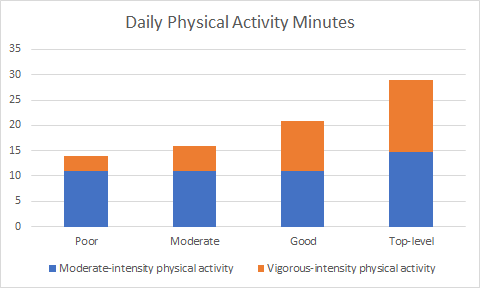
Overview
Being in good physical condition makes you feel better, affirms Firstbeat, the leading heartbeat analytics company for health, fitness and well-being. The firm’s latest research also reveals differences in daily physical activity patterns between different fitness levels. While participants across all fitness level categories averaged similar amounts of moderate-intensity physical activity, substantial differences were revealed in quantity of vigorous-intensity physical activity performed. These finding build a compelling case that regular physical activity of sufficient intensity enhances feelings of personal well-being.
Method
Findings are based on analysis of a sample (n=30,000) selected from the over 200,000 Lifestyle Assessments performed by the company worldwide over the past decade. Data contained in the research database includes over 2 million hours of round-the-clock, high-definition heartbeat recording data. Men and women were equally represented, and the average participant age was 43 years old.
The Firstbeat Lifestyle Assessment aims to improve overall well-being by providing personalized insight into participant stress, recovery and performance. The fact that data is recorded during real-world work and leisure activities ensures that insights gained from the assessment can be applied for maximum impact for the individual. In addition to Finland, where the firm originates, Firstbeat conducts thousands of assessments yearly in the United Kingdom, Germany, Austria, Sweden and Hungary.
During this exploration, Firstbeat researchers and analysts examined the relationship between fitness level and personal well-being. The topic of well-being was explored both through self-perception and through physiological data obtained through physiological measurement and analysis. Firstbeat’s data and analysis is frequently used in scientific research to examine topics of stress and recovery, the impacts of physical activity, and to understand the efficacy of exercise prescriptions.
Linking Fitness and Personal Well-being
According to the Firstbeat database, which combines the results of a preliminary participant questionnaire with measured and analytic data, only 49% of participants who described their fitness as Poor report feeling well. This contrasts with participants in who described their fitness as Good or Top-level, who reported feeling well at rates of 85% and 91% respectively.
Analysis of participant heartbeat data reveals a scientific basis for these perceptions linking fitness level and well-being. Participants who described themselves as being in Good or Top-level physical condition experienced less measured physiological stress throughout the day, and also demonstrated enhanced physiological resilience in the form of better recovery.
Firstbeat stress and recovery insights are based on an analysis of beat-to-beat changes in heart function, a phenomenon known as heart rate variability (HRV). This type of analysis is used to reveal the interplay between the sympathetic and parasympathetic parts of the autonomic nervous system, as they work in tandem to regulate physiological functions in response to the challenges of life and environment.
“Our database research confirms that physically active people have better balance between stress and recovery, and they perceive their well-being with all its components better than those who are less active. This emphasizes the significance of exercise as a promoter of overall well-being and stress management,” says Firstbeat’s head of physiology research Tero Myllymäki.
When the quality of recovery is sufficient, the self-estimated energy level increases. That means those who are physically active not only benefit from excellent restorative sleep, but also feel more energetic compared to those who are less active. Alcohol consumption, obesity, and shortened/irregular sleep patterns were also shown to negatively impact the restorative quality of sleep.
Revealing Differences in Fitness Levels and Activity Intensity
The World Health Organization (WHO) recommends that adults aged 18-64 perform at least 150 minutes of moderate-intensity, or 75 minutes of vigorous-intensity aerobic physical activity each week. Moderate-intensity physical activity involves moderate effort and a noticeably accelerated heart rate, while vigorous-intensity physical activity involves large efforts and results in rapid breathing and a substantially elevated heart rate. These recommendations are designed to guide individuals towards health benefits related to being sufficiently active.
Analysis of the Firstbeat database revealed only relatively minor differences between the amount of average daily moderate-intensity physical activity performed by participants across the different fitness categories. Those who described their fitness as Poor, Moderate, and Good each averaged roughly 11 minutes of moderate-intensity physical activity per day. Those who described their fitness as Top-level recorded an average of nearly 15 minutes of moderate-intensity physical activity per day.

The primary difference in measured activity between participants of different fitness levels came in form of varying vigorous-intensity physical activity durations. Participants who described their fitness as Poor recorded only 3 minutes of vigorous-intensity physical activity per day. Those describing their fitness level as Moderate averaged 5 minutes per day, while a substantial jump in vigorous-intensity physical activity to 10 minutes per day was recorded by those who classified their fitness as Good. Not surprisingly, participants who described their fitness as Top-level topped the scale with an average of nearly 15 minutes of vigorous-intensity physical activity per day.
Is boosting your daily vigorous activity minutes the best way to climb the fitness ladder? The answer may not be quite that simple, claims an expert familiar with the project who takes a longer view on the subject with an eye towards sustainability.
“Vigorous exercise is certainly the best way to improve your fitness levels. However, achieving the health-enhancing effects of exercise require being physically active in the long-term. Thus, from a health perspective, it is essential that exercising becomes a habit. Rather than rushing towards vigorous activities, it is better to perform exercise at an intensity level that feels comfortable, as that kind of activity more easily becomes a habit. Personalization is always key when talking about exercise prescriptions. A person’s physical history and condition as well as possible illnesses and cautionary symptoms should all be fully noted when giving recommendations,” states professor of sports medicine Urho Kujala from the University of Jyväskylä, who has been involved in research made with Firstbeat data.
Further information
Tero Myllymäki
Firstbeat Head of Physiology Research
+358 40 749 7595
tero.myllymaki@firstbeat.fi
Inquiries
Herman Bonner
Communications Specialist
+358 44 343 7626
herman.bonner@firstbeat.com
If you liked this article, you should subscribe to our mailing list